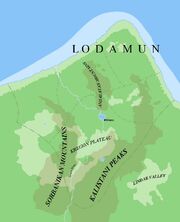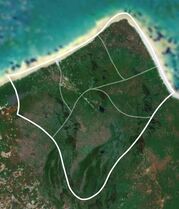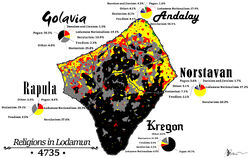Motto | |||||||
| Anthem | "Great Lodamun" | ||||||
| Capital | Kensington, D.J. | ||||||
| Largest city | Harrington | ||||||
| Language | Luthorian | ||||||
| Religion | Hosianism | ||||||
| Ethnic Groups main |
Lodamese | ||||||
| others | Gao-Showan | ||||||
| Demonym | Lodamese | ||||||
| Government | Federal Semi-Presidential Republic | ||||||
| President | Kristen Carter | ||||||
| Chancellor | Jade George | ||||||
| Legislature | National Congress | ||||||
| Area | 1,590,600 km² | ||||||
| Population | 99,487,665 | ||||||
| GDP Total: |
248,519,653,388 LOD (5394) | ||||||
| per capita | 2,497 LOD (5394) | ||||||
| Established | 5394 (3rd Commonwealth, Current Republic) | ||||||
| Currency | Lodamun Dollar (LOD) | ||||||
| Time Zone | GMT +5 | ||||||
| summer | GMT +6 | ||||||
| Drives on the | Right | ||||||
| Calling Code | +19 | ||||||
| Internet TLD | .lo | ||||||
| Organizations | Seleyan Union | ||||||
Lodamun, officially the Commonwealth of Lodamun, is a federal state in northern Seleya. It consists of five distinct provinces that create a nation of over 99 million people. The country is located on the northern tip of the continent of Seleya and has been in existence since August 2037, making it one of the oldest in the world.
Etymology[]
The latter part of the name Lodamun: '-mun', may originate from the Akigan word 'mun' meaning 'to beg', or could be a reference to a 'maund' - a small basket held out by beggars for money.
History[]
3538 - Formation of the "Democratic Republic of Lodamun"
3638 - Formation of the "Great Democratic Republic of Lodamun"
3912 - Formation of the "Federal Republic of Lodamun"
3984 - Formation of the "Second Great Democratic Republic of Lodamun"
4520s to mid-4540s - "The First Era of Southern Dominance"[]
4532 - Formation of the "First Co-operative Federative Republic of Lodamun"
Mid-4540s to 4610s - "The Parliamentarian Era"[]
4548 - Formation of the "Republic of Lodamun"
4575 - Formation of the "Third Great Democratic Republic of Lodamun" - Primarily ruled by the then-Lodamese Green Coalition
4610s to 4720s - "The Second Era of Southern Dominance" or "The Princely Century"[]
4623 - Formation of the "Second Co-operative Federative Republic of Lodamun" - Primarily under the Ecofeudalist-Antinatalist Peasant Party's Dauxite regime with a Prince-Presidential pseudo-monarchy in place since 4626
4683 - Formation of the "First Princely Republic of Lodamun" - Descended into slow stagnation at the beginning of the 48th century.
4720s to 4770s - "Dual Power Period"[]
4733 - Formation of the "Fourth Great Democratic Republic of Lodamun" - Period was characterized by the slow dismantlement of old Princely politics, rise of the Northern Communes and escalation of violence. Apex of violence during the assassination of Prince-Presidential claimant Demetrius I in 4761. Northern Communes achieved independence in 4773 and came to dominate Lodamese politics as a whole
Mid-4770s to circa mid-4830s - "Union Period"[]
4790 - Formation of the "Union of Free Socialist Republics", (UFSR)
4811 - Formation of the "Union of Sovereign Nationalist Republics", (UNSR)
4830s to 4860s - "Musical Chairs Generation"[]
4854 - Formation of the "Democratic Socialist State of Lodamun" - A one-party regime led by the politicians of Pro Lodamunese Unitarian Party
4860 - Re-formation of the "United Republics of Lodamun" - A one party counterrevolutionary government led by Anti-Revolutuonary Party (sic!)
4863 - Re-formation of the "Union of Free Socialist Republics"
4860s onward[]
4866 - Formation of the "Fifth Great Democratic Republic of Lodamun"
5018 - The Seleya Republican Party rose to power after the Democratic Party of Seleya collapsed and vacated the government. Under the new leadership, the party is wasting no time to fix unethical, inhumane laws of the nation and bring Seleya (Lodamun) back to greatness. President Withers and with the support of the Senate, is pushing a name change to "United States of Lodamun."
5019 - Over 10 treaties proposed by the Foreign Affairs department is to be fully ratified between January and February.
5021 - The Democratic Republican Party comes onto the political stage in Lodamun as the nation enters a two party system. The TGLRP has passed a comprehensive reform act for the nation ranging from Economy, Military, Health, Senate seats, etc.
5029 - 5035 - TGLRP, Lodamun Independent Party, Constitution Party of Lodamun, Lodamun National Democratic Party, and Lodamun Democratic Progressive Party are the dominant parties in the nation. TGLRP and LNDP have a prominent rivalry between each other. Comprehensive reforms from Social Reforms to constitutional amendments are passing through.
5124-5179 - The right-wing Grand Democratic Party of Lodamun dominates Lodamese politics, controlling the Presidency for 31 of the 55 year period and introducing official recognition of Hosianism in 5160.
5179 - 5211 - The returned Lodamese Democratic Progressive Party dominates national politics.
5393 - Lodamun enters a period of chaos and instability following the collapse of both the government and the National Congress. In July 5393, a snap election was called by the Supreme Court of Lodamun which saw a landslide victory of the relatively new party, Lodamun Liberal Party. Kristen Carter was sworn in as the new president a few weeks following the election.
5394 - Following the passage of constitutional reform, the office of the Prime Minister of The Commonwealth was created, having this position be the primary office to handle all government operations with the Presidency being moved towards a symbolic position. Interim Prime Minister Lit has dubbed this as the creation of the 3rd Commonwealth of Lodamun.
Geography[]
Lodamun has a wonderfully diverse geography. It is possible for Lodamese to sunbathe on the golden beaches of Andalay before traversing through the semi-tropical jungles of the interior, and finally climbing the snow topped peaks of the Kalistani Mountain Range in southern Kregon.
Physical[]

Physical Map of Lodamun
Lodamun is broken up by three major mountain ranges. The Andalayan Mountains in eastern Golavia are the lowest range, their rolling slopes covered in terraced farming. The Sorbanikan Mountains, reaching from eastern Valruzia through western Kregon and into Rapula, have historically provided a western bulwark that protected the Kingdom of Kregon from nearly all invaders. Finally, the tallest of the Lodamun mountain ranges are the Kalistani Peaks, which provide a natural border with Baltusia in the south and Kalistan in the east.
Interestingly, the V shape created by the adjoining of the Sorbanikan Mountains and the Kalistani Peaks, bisected by the Lindar River, forms the Kregon Plateau, one of the most intensely cultivated regions in the world, producing a wide variety of crops in perfect agricultural conditions.
The nations largest waterway is the Lindar River, which starts deep in Valruzia, before cutting a path through the valley that separates the Sorbanikan Mountains from the Kalistani Peaks. The river continues through Kregon and Golavia, before reaching the sea near the port of Jorka.
Norstavan is covered with many river deltas and is the gateway for goods entering Lodamun from the east. There are also many shipping industries in Norstavan making it the country's top ship manufacturer.
Golavia has many lush forests and jungles which makes it a prime location for the lumber industry. Farming is also important to eastern Golavians.
Inner Rapula and the whole of Kregon are traditionally much cooler and are home to several mountain ranges. Mountains and valleys are located across the two regions.

Lodamun from space
Climate[]
As mentioned previously the climate of Lodamun is as varied as its physical geography. Lodamun lies north of the equator and thus has a fairly warm climate throughout the year. However snow is visible all year round in the Kalistani Peaks. Due to this Lodamun is a popular tourist destination, with its excellent beaches, and all year skiing.
Government and Politics[]
Lodamun is a federal presidential constitutional republic. Although the nation has seen numerous political structures, its foundations are deeply entrenched in democratic traditions such as free and fair elections, equal rights and free speech.
The federal government is divided into three (3) branches
- Legislature: The bicameral Parliament of Lodamun, composed of the House of Commons and the Senate.
- Executive: The President, Prime Minister, and cabinet members.
- Judiciary: The Supreme Court of Lodamun and other federal courts who are appointed by the president following the approval of the Congress.
Administrative divisions[]
Lodamun has five (5) states — Barrington, Berkwaki, Millford, Newchester and St. Christopher and one special administrative district — Kensington, D.P, which is the capital city of the Commonwealth.
Military[]
The government of Lodamun maintains a medium sized professional armed forces broken down into four separate services, the Lodamese Army, the Lodamese Navy, the Lodamese Air Force and the Lodamese Marine Corps. Police forces are organized along Commonwealth and State lines and are issued with standard firearms except for elite units.
Economy[]
Lodamun's location on the continent makes it a key location for trade: it is easily reachable from four other continents. Lodamun remains the banking center of the world. To reinforce its trading credentials, the government of Lodamun proposed a Comprehensive North Seleyan Trade and Diplomatic Agreement to further develop trade in northern Seleya.
Shipping[]
Andalay and Norstaven have historically been centres of ship building and shipping.
Banking[]
Norstaven and Kregon are financial centres.
Agriculture[]
Agriculture is important in Golavia, Kregon and Rapula. Fishing is important in the two coastal states along with growing of various crops. Kregon is a centre of cattle ranching.
Forestry[]
Forestry is a key economic activity in Golavia and Rapula.
Tourism[]
Port Andalay is Lodamun's most lively tourist district. Andalay and Norstaven are blessed with golden beaches. Golavia has a great deal of history. The Kregonese mountains offer fantastic skiing opportunities in winter. A small amount of eco-tourism happens on the other side of Lodamun, in the forests in Rapula.
Infrastructure[]
Education and Health[]
Lodamun maintains a welfare state with state provided health care. The state also provides education. However in areas of health and education private organisations also provide services. In 5213 the government of Lodamun gave all university establishments self-government.
Demographics[]
Ethnicity[]
Lodamun is a diverse multicultural country. The population has various origins with the Mashcara representing the native population, descendants of Artanians, Esinsundu and other diverse groups being well represented. The population is largely mixed so some academics have disputed the validity of census data in which participants are able to self-select an ancestry. Census data collected in the 5210's suggested the following ethnicities.
- White/Artanian Lodamese – 49.5% - Diverse mix of Artanian backgrounds, with Luthori, Hulstria, Dundorf and Dolgava being heavily represented.
- Black/Esinsundu – 19% - Historically descendants of slaves and more recent immigrants.
- Mashcaran – 10%
- Gao-Showa Lodamese – 8% - More recent immigrants from Indrala, Sekowo and Mikuni (Gao-Showa from Hulstria).
- Mixed Race – 7%
- Pensio – 4% - The Pension are a mix of Mashcaran and Egelion. Recent migrants from Gaduridos and Tukarali.
- Other – 2.5%
Religion[]
Lodamun has great religious diversity. In census work conducted in the 5210's a large number of religions existed in Lodamun.
- Hosianism – 51%
- Charismism – 22%
- Aurorian Patriarchal 8%
- Confessional Luthoran – 5.5%
- Restorationist/Latter Day Hosians – 5%
- Brethrenist – 2.5%
- Terran Patriarchal – 2.5%
- Bishopal – 2%
- Amelioratism - 1.5%
- Other Hosian (RL: Other Christians) – 2%
- Inkolo Esintsundu Sizwe Syncretism – 8.5%
- Native Mashcaran Religions – 5%
- Lodamese Nationalism – 5%
- Daenist – 3%
- Jienism – 2.5%
- Yeudism – 1%
- Ahmadism – 0.5%
- Other – 2%
- None - 21.5%
Lodamese Nationalism[]

Religious demographics of Lodamun in 4735
Lodamun has a varied religious history. Lodamese Nationalism was officially introduced by the Edwin Fertig administration in May 3515. After that, the government made attempts to suppress all other religious influences. For continuous decades, Lodamese Nationalism was a mandatory religion, and all foreign influence was suppressed by law, weakening other religions. The government eventually purged the members of other religions and forced conversions. The entire population of Lodamun was registered as being members of Lodamese Nationalism. Lodamese nationalism continued to have state support throughout much of the 4th and 5th millenniums, but by the start of the 6th millennium has significantly weakened.
Hosianism[]
Despite official persecution throughout periods of Lodamese history, Hosianism has always maintained a presence. Several Hosian denominations are native to northern Seleya (see Charismism and the Restorationist Church) and have often flourished. Other denominations have been introduced by immigrants.
Hosian "Lodamese Awakening"[]
Since middle part of the 52nd century there has been a Hosian religious revival in Lodamun described as the "Lodamese Awakening" by academics. The revival was encouraged by the governing Grand Democratic Party of Lodamun with legislation in 5160 that recognized Hosianism as the official religion in Lodamun and offered preferential treatment to six Hosian denominations.
- Charismic Churches in Lodamun
- Ameliorate Churches
- Bishopal Churches
- Confessional Churches
- Brethrenist Churches
- Restorationist Church of Eliyahu and Latter Day Hosians
This revival has continued into the start of the 53rd century, with President Bergmann a noted Charismic congregant, and the Restorationist Church relocating its HQ to Lodamun.
Inkolo Esintsundu Sizwe Syncretism[]
Amongst Lodamuns large Esinsundu population a large number practice Inkolo Esintsundu Sizwe Syncretism. Perhaps as many as 8.5 million Esinsundu Lodamese adhere to the religion, making it one of the largest religions in Lodamun.
Language[]
A multitude of languages are spoken in Lodamun, although Luthorian is widely acknowledged as the official and most spoken language, with most Lodamese either speaking it as a primary or secondary language. The list below details the language spoken at home in the census returns from the 5110's.
- North Seleyan Luthori – Primary language – 57%
- Esinsundu Luthori – Widely spoken patois – 12%
- Native Mashcaran – 7%
- Gao-Showan languages – 6%
- Dundorfian/Hulstrian – 6%
- Dolgarian – 3%
- Egelion – 3%
- Valruzian – 2%
- Other – 4%
Culture[]
Lodamun as a whole does not have a single culture per se; instead, each region has it's own culture and traditions. However, the majority of Lodamese citizens embrace not only the culture and traditions of their own region, but also participate in the culture and traditions of other regions too. Furthermore, Lodamun has a high number of immigrants and people whose ancestors came from abroad which makes Lodamun's culture even more diverse. It could be suggested that Lodamese culture is a blend of not only five cultures, but also a blend of the cultures of many other countries too.
Andalay and Golavia were traditionally royalist due to the large Hulstrian and Hulstrian Lodamese population living there. Large castles and palaces are evident in both regions despite Lodamun traditionally being a republican nation. Ancestors of once royal families that date back to the period of the United Kingdoms of Lodamun still have influence in those areas. The Karavs have based themselves in Kregon instead of Andalay or Golavia. The government has tried to buy castles from families in Golavia for public use, while leaving Andalay as the upper class province.
Nationwide, citizens enjoy the many rivers for them to fish and the Lodamese enjoy the outdoors and rural activities. Furthermore, the majority of the population still live in the countryside or in small, scattered towns, rather than in cities around Lodamun.
Sport[]
The Lodamese are passionate followers of sport. At an individual level sports such as tennis, badminton, squash, hunting and fishing are all popular. Team sports are also popular with Lodamese Football and Lodamese Stickball officially recognised as national sports.



